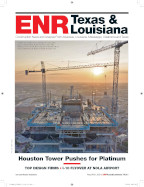 Williams Brothers
|
 Williams Brothers
Interchange included a dozen new bridges and a medley of ramps for two Interstates.
|
The completion of a major interchange in Houston last month marks a milestone in building one of North America’s widest highways. A hefty incentive program plus a rare lane rental method spurred Williams Brothers Construction Co., Houston, to complete the Interstate 10/610 interchange in less than four years and win an $11.4-million bonus.
The $263-million interchange is the largest of 10 sections along the $2.7-billion I-10 Katy Freeway corridor that is being reconstructed and expanded to as many as 18 through lanes and up to six auxiliary lanes. Texas Dept. of Transportation officials are confident that incentives and corridor-wide project management methods are working. “It’s not the first time we’ve had high incentives,” but never at such high levels, says Clifford Halvorsen, TxDOT aea engineer.
Initial funding was earmarked in the 2002 federal transportation appropriations bill with the understanding that TxDOT would pursue alternative delivery methods. TxDOT hired Parsons Brinckerhoff, New York City, as program manager. “Our resources were not such that could handle the time frame and enormity of the job,” Halvorsen says. The 23-mile stretch handles more than 200,000 daily vehicles and sections are expected to handle almost 300,000 a day in the next 20 years.
 Williams Brothers
Shutting lanes during normal traffic hours would be costly.
|
Williams Bros. built eight connector ramps, a dozen steel box girder or concrete box girder bridges, and three miles of mechanically stabilized earth walls or drilled shaft walls. Crews did everything possible during weekend closures, helped by good weather, says project manager Eric Sommer.
Various incentives for contractors on the 10 sections add up to about $66 million, says Milner. The whole corridor is more than 75% complete, with one final contract for paving markings to be let next year. The new freeway will include managed toll or high-occupancy vehicle lanes, operated by the Harris County Toll Road Authority, in the median of the existing I-10.
The job would normally take up to three years to design, but here it took two years, says Ron Kline, project manager for lead designer Reynolds, Smith and Hills Inc., Tampa, Fla. “It led to a lot of trying times and long hours. We had to redesign things around pending rights-of-way acquisitions. A lot of utilities waited to be relocated, and you had to work around that. This project waits for nobody.” Rights-of-way acquisitions cost some $500 million and utility relocations about $365 million. If a utility relocation or acqui-sition was delayed in one area, “we worked anywhere else we could,” he says. “It was like working with one arm tied behind your back.” Incentives include $700,000 for unused hours allowed under the lane rental agreement. TxDOT has used the method once before, on the Dallas High-Five project. “We came up with a certain number of hours that he would need, applied a dollar amount per lane per hour and multiplied it out,” says Halvorsen. For example, if Williams closed one lane of I-610 during peak weekday hours, it would pay up to $13,800 per hour. But it could close one lane between 9 p.m. and 5 a.m. as many days as needed for free. If crews wanted to close three lanes overnight, they had a total of 240 hours allotted. “We will receive a $700,000 incentive for not utilizing all the closure times available,” says Sommer. “Until recently, this approach and use of incentives was uncommon in Texas,” says David Milner, PB program manager. Now, “Texas DOT expects similar approaches to be implemented on major projects.”

Post a comment to this article
Report Abusive Comment